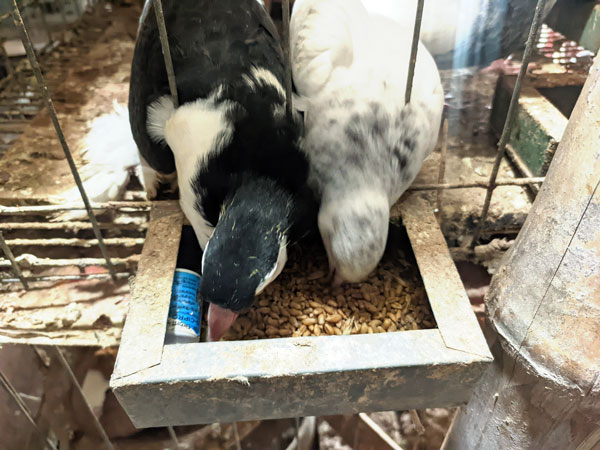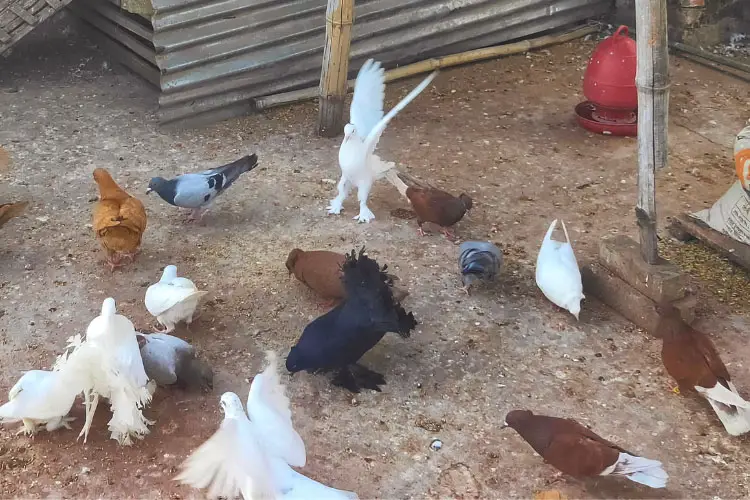Why Is Pigeon Poop White? Unraveling The Mystery
If you have been around pigeons, you must have seen their whitish poop. It’s the same waste that most urban homeowners hate about pigeons. But that may not bother you. You are only curious about the color of their poop.
And you ask, why is pigeon poop white? Pigeon poop is mostly composed of uric acid, a whitish paste. These birds can’t break down uric acid to urea as mammals do. The ammonia and other waste get converted to uric acid and excreted as a white substance.
But how does it happen? Is there a biological or nutritional reason behind this? Read on to learn more as we unravel the mystery.
Why Is Pigeon Poop White?
The answer to this age-old mystery is that pigeons or birds don’t produce urine like mammals. Instead, they excrete nitrogenous wastes in uric acid. Unlike liquid waste, it does not dissolve easily when exposed to water or other liquids.

This substance appears as a thick paste or plaster-like substance and sticks to surfaces quite well. It primarily comprises ammonia, guanine, uric acid crystals, carbon dioxide, and small amounts of other nitrogenous compounds.
But Why Uric Acid?
Uric acid’s hardness contributes significantly to its ability to resist dissolution in water. It is this property that gives pigeon poop its regular white-colored appearance.
The chemical structure of uric acid further ensures that only minimal water absorption occurs during its transportation. This creates the slightly gummed-up consistency observed in bird droppings and often seen on car windshields and other surfaces.
In healthy birds, two types of urine are produced: solid urine (white uric acid crystals) and liquid urine (clear or yellowish). If a bird’s droppings are mostly liquid with no solid parts, this could indicate that either its crop is not emptying properly or it may be starving.
Excess urine in the droppings may also be an indication of kidney disease if there has been minimal fruit intake over the last 24 hours. Some toxins can cause kidney damage which can lead to abnormal droppings in birds.
What Is The Biological Reason for White Poop in Pigeon species?
Pigeons have a complex digestive system responsible for creating their excrement, which contains both liquid and solid components.
- The primary elements making up pigeon poop white are nitrogenous wastes from uric acid, ammonia, guanine, and carbon dioxide. There are also other small amounts of nitrogenous compounds formed along the way.
- Unlike mammals, pigeons do not have separate exits for urine and feces. Both waste products are eliminated through a single opening called the cloaca.

This means that the bird’s digestive system does not produce urea as mammals do. But instead, produces uric acid, which is then excreted as a pasty white substance.
- Uric acid is formed within the reptile filtration units in the bird’s kidneys and bladder. It is then passed into the intestine, combining with other waste products to form a paste-like substance.
This paste-like substance is then expelled from the body through the cloaca as droppings or feces. And the combination of these substances gives pigeon droppings the characteristic of white color.
What Is The Role Of Nutrition In Pigeon Feces Coloration?
The color of various pigeon droppings can differ depending on the type of flora and fauna found in the habitats where they live and feed.

- Pigeons tend to eat seeds and grains that are high in proteins, so digestion produces nitrogenous compounds. The process is called anaerobic respiration, which occurs within the gizzard during digestion.
- On the other hand, if such birds consume more plant-based foods higher in carbohydrates or lipids, their poop may be slightly darker. That’s due to a larger population of bacteria within their intestines breaking down these organic materials.
- Studies have shown avian species with diets containing more proteins. And nutrition plays a major role in determining the quality and quantity of fecal matter produced by birds. Those with diets higher in proteins tend to excrete white-colored uric acid-based stools.
- At the same time, those consuming greater amounts of lipids or carbohydrates will appear slightly darker. The bacteria break down these substances differently, resulting in different colors being seen after defecation has taken place.
What Other Factors Affect Pigeon Dropping Colors?
In addition to the excretion of nitrogenous waste from uric acid, it’s not always whitish brown. There are several other factors that can impact the color of pigeon droppings. These factors include:
- Diet: The type and quality of food that birds consume can impact the color of their droppings. For example, a diet high in yellow or green foods may result in yellow or green droppings.
- Hydration: Hydration levels can also impact the color of bird droppings. If birds are dehydrated, their droppings may be more concentrated and darker in color.
- Age: The bird’s age can also impact the color of its droppings. For example, young birds may have softer, lighter-colored droppings compared to adult birds.
- Health: The bird’s health can also impact the color of its droppings. For example, a sick bird may have abnormal droppings, such as blood in their droppings, which is a sign of internal bleeding.
Other Animals With White Droppings: Comparing And Contrasting
Pigeons are not the only animals with white droppings. Many species of birds, reptiles, and even some mammals have white droppings. Some of the other animals with white droppings include:

- Other Birds: Besides pigeons, other birds, such as seagulls, swifts, and doves, also have white droppings. This is because their excretion of nitrogenous waste from uric acid is similar to that of pigeons.
- Reptiles: Reptiles such as snakes and lizards also have white droppings due to their excretion of uric acid.
- Rodents: Rodents such as hamsters and guinea pigs also excrete nitrogenous waste from uric acid, resulting in white droppings.
Despite these similarities, there are also differences in the color and texture of droppings between different species. For example, bird droppings may be pastier and stickier than reptile droppings, which may be more solid and less sticky.
These differences can be attributed to differences in diet, digestive systems, and excretion processes between different species.
If you’re interested in learning more about pigeon behavior and care, our articles on pigeon vocalizations and baby pigeon care can provide useful information. Our article on what sound does a pigeon make covers the different types of vocalizations that pigeons use for communication and what they mean. If you’re caring for baby pigeons, our article on baby pigeon care provides helpful tips and advice on how to feed, house, and care for young pigeons. With our articles, you can deepen your understanding of pigeon behavior and care and provide the best possible environment for these fascinating birds.FAQs
Here are some frequently asked questions to help you better understand bird droppings:
Bird poop typically ranges in color from white to dark brown, depending on the species of bird and its diet. Many birds produce white droppings due to their excretion of nitrogenous waste from uric acid.
Yes, the type and quality of food that pigeons consume can impact the color of their droppings. A diet high in yellow or green foods may result in yellow or green droppings.
Yes, changes in the color of pigeon droppings can signify a health issue. It is recommended to consult a veterinarian if you notice any significant changes in the color of your pet bird’s droppings.
Conclusion
Pigeon poop is white due to the presence of nitrogenous waste from uric acid, ammonia, guanine, and carbon dioxide. Uric acid’s hardness contributes significantly to its ability to resist dissolution in water. This gives pigeon droppings their regular white-colored appearance.
Diet, hydration levels, age, and health can also impact the color of bird droppings. Accordingly, changes in the color of pigeon droppings can signify a health issue. Therefore, it is important to consult a veterinarian if you notice any significant changes in your pet’s droppings.






